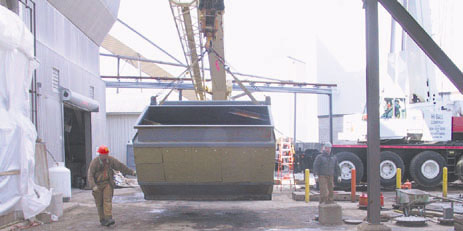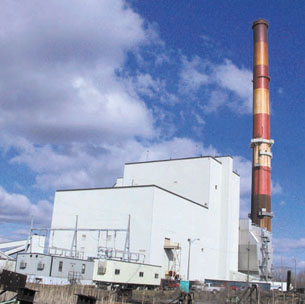A better way to burn coal introduced to Erickson Station
Date Posted: March 19 2004
One of the largest capital improvement projects at the Lansing Board of Water and Light’s Erickson Station powerhouse in the last two decades is now taking place, and the building trades are all over it.
The Erickson plant has been shut down for the work since Feb. 1 and is scheduled to reopen on April 9. During that time, the trades are making modifications that will allow the Erickson plant to burn more environmentally friendly Western coal, which has a lower sulfur content. At the same time, modifications to the plant will allow it to maintain its generating capacity, despite the use of the cooler-burning coal.
“This is a unique project,” said Lansing Board of Water and Light Principal Mechanical Engineer Dan Flynn. “To the best of our knowledge, no one in the U.S. or Canada is making modifications of this type to a plant of this size.” Capable of producing 165 megawatts, the Erickson plant is relatively small, but it is the biggest power producer owned by the Board of Water and Light.
Other Michigan powerhouses we have visited in recent years have chosen to install expensive and complex selective catalytic reducers (SCRs) as part of federal mandates to reduce their Nitrous Oxide (NOx) emissions. This project will help the Erickson plant to meet federal emissions requirements by efficiently burning the lower-sulfur, lower polluting Powder River Basin (Wyoming) “sub-bituminous” coal rather than the Eastern bituminous coal it was design to burn.
Major contractors on the project include Jamar Construction, Northern Boiler, Superior Electric and Matsui Babcock. About 120 construction workers are toiling on the project during this outage.
During this project, a number of new fixtures are being installed, including: over-fire air ports, water cannons to clean the furnace walls, a new primary air heater system and associated duct work, and a new ash removal system. In addition, modifications will be made to the coal crusher area, and boiler heating surfaces will be converted.
The “over-fire” air that will be added to the coal-burning process will add more combustible air around the coal as it burns, which will help bring about fewer NOx emissions.
“There are some unique things about this job,” said Tom Delaney, a Plumbers and Pipe Fitters Local 333 member and superintendent for Northern Boiler. “I think the trickiest part has been putting in the new division wall in the boiler. That’s a retrofit you don’t usually see.” The division wall will help in the transfer of heat in the boiler.
Brought on line in 1973, the Erickson Station has a single generator and has been rated one of the most efficient plants of its size in the United States. The last major upgrade in the plan was in 1998, when a new pollution controlling precipitators and associated duct work were installed.
The plant serves the greater Lansing area.
Flynn said preparations and some work for this $25.7 million project began in 1999, and work “really got serious” in 2003. The plant’s goal is to be in compliance with federally mandated lower NOx emissions by June of this year.
“The tradespeople have been super out here,” Flynn said. “I’ve never had any major problems with the crafts in the 19 years that I’ve been here. We’re working under a very hectic schedule and we’ve had some issues, but certainly none of them have been caused by the tradespeople.”

GUIDING A GAS inlet duct at the Lansing Board of Water and Light's Erickson Station are Steven Fitzpatrick and Josh Klauss of Boilermakers 169.

THE ERICKSON STATION and its signature 475-foot-tall stack were completed in 1973. An ongoing outage at the plant will last through April 9.
